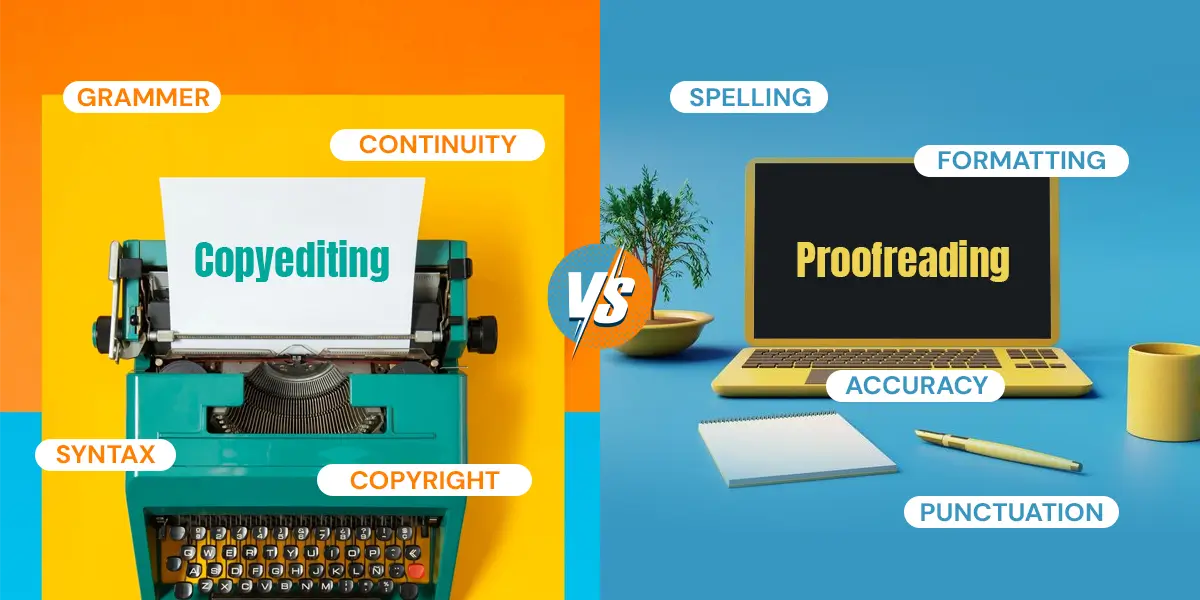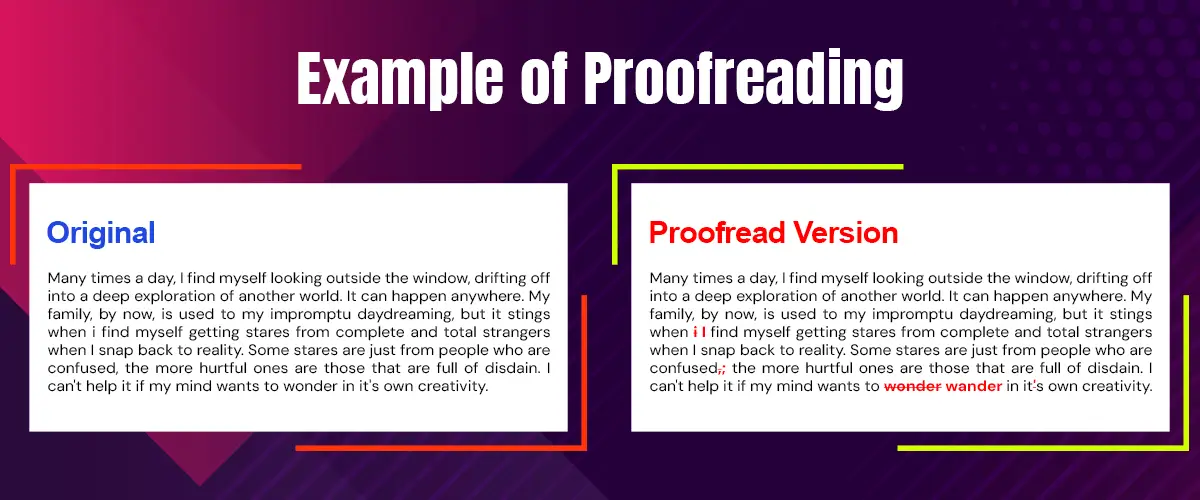Proofreading vs. Copyediting - A Comparative Analysis
When it comes to refining written content, two terms often create confusion—copyediting and proofreading. Though both involve reviewing and correcting text, they serve different purposes at distinct stages of the editing process.
This blog is designed to clearly explain the difference between copyediting and proofreading, so you can confidently choose the right approach for your writing needs. Whether you're a student, writer, or business professional, understanding this distinction is essential for producing polished, error-free content.

What is Proofreading?
Proofreading is the final step in the editing process, focusing on identifying and correcting surface-level errors in a written document. It ensures that the text is free from grammar, spelling, punctuation, and formatting mistakes before publication or submission. While copyediting deals with clarity, tone, and sentence structure, proofreading is about accuracy and correctness at the final stage.
Key Aspects Taken into Consideration During Proofreading:
- Spelling Mistakes: Checking for typos and incorrect spelling.
- Grammar Errors: Ensuring subject-verb agreement, proper use of tenses, etc.
- Punctuation: Correct use of commas, periods, apostrophes, quotation marks, etc.
- Capitalization: Making sure proper nouns and the start of sentences are correctly capitalized.
- Consistency: Uniform use of dates, hyphenation, abbreviations, and number formatting.
- Formatting: Verifying font style, spacing, alignment, and layout uniformity.
- Typographical Errors: Fixing double spaces, broken links, or incorrect symbols.
Role of a Proofreader
A proofreader plays a critical role in ensuring that content is clean, error-free, and ready for its final audience. Their work is vital in publishing, academia, business, marketing, and journalism.
Responsibilities of a Proofreader:
- Carefully review texts for typographical and linguistic errors
- Verify consistency in formatting and style
- Make corrections without altering the writer’s intended meaning
- Ensure content aligns with specified style guides (e.g., APA Stylebook, Chicago Stylebook)
- Collaborate with editors and writers to finalize the draft
Proofreading Checklist

A comprehensive proofreading checklist helps ensure no critical element is overlooked:
- Spelling consistency and accuracy
- Proper grammar and sentence construction
- Correct punctuation usage
- Consistent formatting and layout
- Appropriate capitalization
- Page numbering and headers/footers
- Accurate tables, charts, and footnotes
- Verified hyperlinks and citations
What is Copyediting?
Copyediting is a crucial step in the editing process that focuses on improving the readability, clarity, and consistency of a written document. It goes beyond just fixing typos—copyediting ensures that the content flows logically, maintains the right tone, and adheres to grammar and style guidelines. While proofreading is the final polish, copyediting is the in-depth refinement that happens before it.
Key Aspects Taken into Consideration During Copyediting
Copyediting is more comprehensive than proofreading and covers the following:
- Grammar & Syntax: Correcting sentence structure, tense, subject-verb agreement, and awkward phrasing.
- Spelling & Punctuation: Fixing common errors and ensuring consistency.
- Clarity & Flow: Rewriting or restructuring sentences to improve readability and logic.
- Consistency: Maintaining uniformity in tone, terminology, headings, style, and formatting.
- Fact-Checking: Verifying names, dates, statistics, and other factual information.
- Style Guide Adherence: Ensuring the content follows editorial guidelines (e.g., AP, Chicago Manual of Style).
Role of a Copyeditor
A copyeditor ensures that the message is not only grammatically correct but also clear, coherent, and aligned with the brand or publication's tone.
Responsibilities of a Copyeditor
- Edit content to improve grammar, flow, and structure
- Eliminate redundancy and unnecessary jargon
- Standardize style, spelling, and formatting
- Cross-check facts and sources
- Maintain author’s voice while enhancing readability
- Communicate with writers to clarify unclear sections
Copyediting Checklist

A professional copyediting checklist includes:
- Correct grammar and syntax
- Clear sentence structure and flow
- Consistent use of voice, tone, and style
- Correct spelling and punctuation
- Accurate facts and figures
- Logical transitions between ideas
- Alignment with the intended audience
- Compliance with brand/editorial guidelines
Key Differences Between Proofreading and Copyediting
While proofreading and copyediting may seem similar, they differ in focus, depth, and purpose. Here’s a closer look at their key distinctions:
-
Focus Areas
- Proofreading: Surface-level errors like spelling, grammar, punctuation, and formatting inconsistencies.
- Copyediting: Structural and stylistic elements, including clarity, flow, word choice, and fact-checking.
-
Stage in the Writing Process
- Proofreading: The last step before publication or submission.
- Copyediting: Performed before proofreading to refine the text.
-
Scope of Work
- Proofreading: Does not alter sentence structure or meaning.
- Copyediting: May suggest rewording or reorganizing content for better readability.
-
Outcome
- Proofreading: Produces a polished document with minimal errors.
- Copyediting: Improves readability, coherence, and clarity of the text.
Why Both Proofreading and Copyediting Matter?
Both proofreading and copyediting play crucial roles in ensuring high-quality writing. Without copyediting, a document might have inconsistencies, unclear phrasing, and factual errors. Without proofreading, even a well-structured document may contain distracting typos and formatting issues.
For professional and academic writing, editing services often include both processes to guarantee accuracy and readability. Whether it's a book manuscript, a business proposal, or an academic paper, using both copyediting and proofreading services ensures high-quality content that reflects professionalism.
Benefits of Proofreading
Proofreading is the final step in the editing process, focusing on eliminating minor errors that may have been overlooked. It ensures that the document is polished and ready for publication.
-
Eliminates Grammar, Spelling, and Punctuation Errors
Even the most well-written documents can suffer from small mistakes. Proofreading helps correct grammatical errors, spelling inconsistencies, and misplaced punctuation, ensuring a polished final product. Mistakes such as "your" vs. "you're" or missing commas can impact readability and professionalism.
-
Ensures Consistency in Formatting and Style
A well-structured document follows consistent formatting and style guidelines. Proofreading ensures uniformity in font size, heading styles, bullet points, citations, and other formatting elements. This is especially crucial for business documents, academic papers, and manuscripts, where inconsistency can affect credibility.
-
Enhances Readability by Correcting Typos and Awkward Phrasing
Even minor typographical errors can create confusion or make a document appear unprofessional. Proofreading ensures smooth and natural sentence flow by identifying and fixing awkward phrasing, redundant words, or unclear expressions.
-
Improves Overall Clarity and Fluency of the Text
Sometimes, a document may be grammatically correct but still sound unnatural. Proofreading refines sentence structure and word choices to ensure that ideas are conveyed clearly and effectively. This is particularly important for non-native English writers who may struggle with fluency.
Benefits of Copyediting
Copyediting is a more detailed process that improves the overall structure, clarity, and effectiveness of the content. It involves refining the language, fixing inconsistencies, and ensuring logical coherence.
-
Refines Sentence Structure and Flow for Better Readability
Copyediting improves sentence structure, eliminating awkward or overly complex sentences. It enhances the natural flow of the text, making it easier to read and comprehend. This ensures that readers stay engaged and absorb the intended message without confusion.
-
Corrects Inconsistencies in Tone, Voice, and Terminology
A professional document should maintain a consistent tone and voice throughout. Copyediting ensures that formal documents don’t have sudden shifts in style and that the terminology aligns with the intended audience. For example, a technical article should use precise industry terminology, while a marketing copy should maintain a persuasive and engaging tone.
-
Identifies and Fixes Factual Errors
Inaccuracies in data, names, dates, or references can damage credibility. Copyediting includes fact-checking to ensure that all information is correct and properly cited. This is especially important for academic research, news articles, and business reports, where accuracy is essential.
-
Strengthens Clarity, Coherence, and Logical Progression
Copyediting ensures that ideas are presented in a clear and logical order. It helps in restructuring content where necessary, improving coherence and eliminating any ambiguities. This makes complex information more digestible, particularly in technical or academic writing.
Why Copyediting and Proofreading Are Essential?
While copyediting refines and improves the content’s structure and clarity, proofreading ensures it is error-free and visually polished. Using both processes guarantees a professional and high-quality final document, making it more impactful and credible. Whether for business, academic, or creative purposes, a well-edited document leaves a lasting impression and enhances communication effectiveness.
When Do You Need Proofreading and Copyediting?
Writers often wonder whether they need proofreading or copyediting—or both. Here are some scenarios where each service is essential:
- If you are a student submitting an important research paper, you might need proofreading services to check for minor errors before submission.
- If you are a business owner preparing marketing materials, copyediting services can help refine your message and ensure clarity.
- If you are an author finalizing a book manuscript, you’ll likely need both services for a polished final product.
- If you are an academic writer, copyediting ensures that your work is well-organized and free from factual inconsistencies, while proofreading eliminates typographical errors.
Conclusion
Both proofreading and copyediting are essential for producing polished, professional content. While proofreading corrects minor errors, copyediting enhances clarity and coherence. Writers, businesses, and publishers benefit from both services to ensure accuracy and readability.
FAQ's
Proofreading focuses on correcting minor grammar, spelling, and punctuation errors, while copyediting improves clarity, sentence structure, and overall readability. Copyediting is a more detailed process that enhances content before proofreading ensures it is error-free and publication-ready.
If your content is already well-structured and just needs a final review for typos, grammar, and formatting errors, proofreading is sufficient. If your document requires clarity improvements, sentence restructuring, or consistency checks, copyediting is the better choice before final proofreading.
Skipping copyediting may result in overlooked clarity, tone, and structural issues. Proofreading only corrects surface-level errors. If your content needs refinement in sentence flow, word choice, and coherence, copyediting should be done first before final proofreading.
Yes. Professional proofreading and copyediting ensure business documents are clear, professional, and error-free. Well-edited content enhances credibility, whether it's a proposal, report, or marketing material, helping businesses communicate effectively and maintain a strong brand image.
If your document is complete but needs sentence restructuring, tone consistency, and fact-checking, start with copyediting. If it's already polished and only requires a final review for minor errors, choose proofreading. Many professional writing projects benefit from both services for optimal quality.



